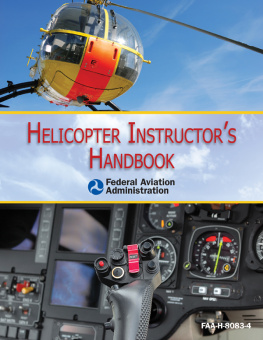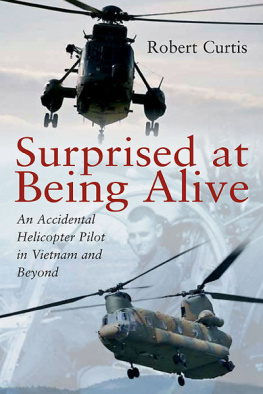Learning to Fly Helicopters
About the Author
R. RANDALL PADFIELD, formerly editor-in-chief of AIN Publications for 14 years and now chief operating officer, has some 9,000 hours of flight time, most of it in helicopters, and is the author of four books on aviation. He holds an Airline Transport Pilot certificate for helicopters and airplanes, flew U.S. Air Force rescue helicopters in Iceland and Alaska and civil offshore helicopters to North Sea oil platforms, and for a short time served as copilot for Donald Trump, flying a VIP-configured AS332 Super Puma. A graduate of the U.S. Air Force Academy, Mr. Padfield holds a masters degree in engineering management from UCLA and received the National Business Aviation Associations Gold Wing Award for reporting excellence in 1998.
Learning to Fly Helicopters
R. Randall Padfield
Second Edition
New York Chicago San Francisco
Athens London Madrid
Mexico City Milan New Delhi
Singapore Sydney Toronto
Copyright 2014 by McGraw-Hill Education. All rights reserved. Except as permitted under the United States Copyright Act of 1976, no part of this publication may be reproduced or distributed in any form or by any means, or stored in a database or retrieval system, without the prior written permission of the publisher.
ISBN: 978-0-07-180862-0
MHID: 0-07-180862-0
e-Book conversion by Cenveo Publisher Services
Version 1.0
The material in this eBook also appears in the print version of this title: ISBN: 978-0-07-180861-3, MHID: 0-07-180861-2.
McGraw-Hill Education eBooks are available at special quantity discounts to use as premiums and sales promotions, or for use in corporate training programs. To contact a representative, please visit the Contact Us page at www.mhprofessional.com.
All trademarks are trademarks of their respective owners. Rather than put a trademark symbol after every occurrence of a trademarked name, we use names in an editorial fashion only, and to the benefit of the trademark owner, with no intention of infringement of the trademark. Where such designations appear in this book, they have been printed with initial caps.
Information has been obtained by McGraw-Hill Education from sources believed to be reliable. However, because of the possibility of human or mechanical error by our sources, McGraw-Hill Education, or others, McGraw-Hill Education does not guarantee the accuracy, adequacy, or completeness of any information and is not responsible for any errors or omissions or the results obtained from the use of such information.
TERMS OF USE
This is a copyrighted work and McGraw-Hill Education and its licensors reserve all rights in and to the work. Use of this work is subject to these terms. Except as permitted under the Copyright Act of 1976 and the right to store and retrieve one copy of the work, you may not decompile, disassemble, reverse engineer, reproduce, modify, create derivative works based upon, transmit, distribute, disseminate, sell, publish or sublicense the work or any part of it without McGraw-Hill Educations prior consent. You may use the work for your own noncommercial and personal use; any other use of the work is strictly prohibited. Your right to use the work may be terminated if you fail to comply with these terms.
THE WORK IS PROVIDED AS IS. McGRAW-HILL EDUCATION AND ITS LICENSORS MAKE NO GUARANTEES OR WARRANTIES AS TO THE ACCURACY, ADEQUACY OR COMPLETENESS OF OR RESULTS TO BE OBTAINED FROM USING THE WORK, INCLUDING ANY INFORMATION THAT CAN BE ACCESSED THROUGH THE WORK VIA HYPERLINK OR OTHERWISE, AND EXPRESSLY DISCLAIM ANY WARRANTY, EXPRESS OR IMPLIED, INCLUDING BUT NOT LIMITED TO IMPLIED WARRANTIES OF MERCHANTABILITY OR FITNESS FOR A PARTICULAR PURPOSE. McGraw-Hill Education and its licensors do not warrant or guarantee that the functions contained in the work will meet your requirements or that its operation will be uninterrupted or error free. Neither McGraw-Hill Education nor its licensors shall be liable to you or anyone else for any inaccuracy, error or omission, regardless of cause, in the work or for any damages resulting therefrom. McGraw-Hill Education has no responsibility for the content of any information accessed through the work. Under no circumstances shall McGraw-Hill Education and/or its licensors be liable for any indirect, incidental, special, punitive, consequential or similar damages that result from the use of or inability to use the work, even if any of them has been advised of the possibility of such damages. This limitation of liability shall apply to any claim or cause whatsoever whether such claim or cause arises in contract, tort or otherwise.
To my ever-loving, always patient, cleverly creative, frequently funny, and thankfully forgiving wife, Moira; our three happy, intelligent, amazing, and much-loved children, Heitha, Dirk, and Tommy, and their spouses, Richard and Dawn; and our clever, spunky, and fun-loving grandchildren, Richie, Nia, Lila, Liam, and Coral, all of whom are showing signs of outdoing their parents and grandparents.
Contents
Foreword
C harles Lindbergh and I both flew out of Roosevelt Field in Garden City on New Yorks Long Island. He did it famously in 1927, and I in utter anonymity some 30 years later. Still, my flightalbeit as a passengerwas also noteworthy since it occurred after the field had become, sadly, the Roosevelt Field Mall and thus may have been among the last flights from the hallowed aviation place.
As youve surely guessed, my aircraft was a helicopter, a classic Bell 47 that my uncle, a friend of helicopter pioneer Frank Piasecki, had sponsored for a brief appearance at the mall. A wide-eyed kid going aloft for the first time, I distinctly recall my surprise at not so much ascending, as I had expected, but rather seeing the ground fall away below me. I knew immediately that this was something special.
Ever since I have marveled at the helicopters unique properties, but they remained largely theoretical as I went on to fly aircraft whose wings were fixed solidly in place, and to write and edit stories about the same.
Then one day in 1980 a manuscript arrived unbidden at the magazine I was then editing that described in riveting detail an environment, a set of circumstances, a discoveryall to the extremethat had tested helicopters and their crews to the limits. The story focused on the Alexander Kielland, a five-legged, semi-submersible drilling rig that had capsized after one of its legs broke off during a furious storm in the North Sea shortly before night. Despite a desperate response by helicopter crews in harrowing conditions, their bravery could not alter the catastrophe, which ultimately claimed 123 lives.
The storys author was one of those responding pilots, an expert rotary-wing aviator, and, as it turned out, a writer of the highest order as well. That was my first encounter with Randy Padfield and, fortunately, weve had many since, as weve traveled parallel paths in publishing.
















